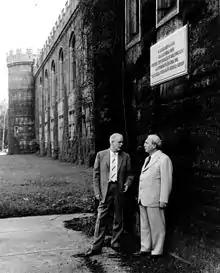Norman Hilberry
Norman Hilberry (March 11, 1899 – March 28, 1986) was an American physicist, best known as the director of the Argonne National Laboratory from 1956 to 1961. In December 1942 he was the man who stood ready with an axe to cut the scram line during the start up of Chicago Pile-1, the world's first nuclear reactor to achieve criticality.
Norman Hilberry | |
|---|---|
 Norman Hilberry (left) with Leo Szilard at Stagg Field | |
| Born | Horace van Norman Hilberry March 11, 1899 |
| Died | March 28, 1986 (aged 87) |
| Citizenship | American |
| Alma mater | Oberlin College, A.B. University of Chicago Ph.D. |
| Known for | Director of Argonne National Laboratory |
| Scientific career | |
| Fields | Physics |
| Institutions | New York University Argonne National Laboratory University of Arizona |
| Thesis | Extensive cosmic-ray showers and the energy distribution of the primary cosmic rays (1941) |
Biography
Horace van Norman Hilberry was born in Cleveland, Ohio, on March 11, 1899. He received his Bachelor of Arts (A.B.) degree from Oberlin College in 1921, and then became an assistant in physics at the University of Chicago. In 1925 he became an instructor in physics at Washington Square College in New York, where he rose to become an assistant professor in 1928.[1][2] He earned his Doctor of Philosophy (Ph.D.) from the University of Chicago in 1941, writing his thesis on "Extensive cosmic-ray showers and the energy distribution of the primary cosmic rays".[3][4]
In 1941, Hilberry joined what would become the Manhattan Project, the effort to create an atomic bomb during World War II. He moved to the University of Chicago to help Arthur H. Compton in any way possible.[5] Hilberry became associate director of Compton's Metallurgical Project.[6] On December 2, 1942, he was present for the start up of Chicago Pile-1, the world's first nuclear reactor to achieve criticality. Because of fears that the reaction could "run away", Hilberry stood ready with an axe to cut the scram line, a manila rope connected to control rods that could quickly shut the reactor down.[7][8] He was also present for the start-up of the X-10 Graphite Reactor in November 1943, and the reactors at the Hanford Engineer Works the following year. He returned to the Metallurgical Laboratory in Chicago in 1945.[9]
Hilberry became assistant director of the Metallurgical Laboratory in 1943.[1] On July 1, 1946, the Metallurgical Laboratory became Argonne National Laboratory, the first designated National Laboratory, with Walter Zinn as director,[10] and Hilberry as associate director. He became the deputy director in 1949, and the director in June 1956,[1] on Zinn's departure. He was the first director of Argonne's International School of Nuclear Science and Engineering, an important part of the Eisenhower Administration's Atoms for Peace program, from 1955 to 1956.[1][9] He stepped down in November 1961, and was replaced by Albert Crewe.[11] He remained at Argonne as a senior scientist until 1964, when he accepted an appointment as Professor of Nuclear Engineering at the University of Arizona. He retired and became a professor emeritus in 1985.[1]
Hilberry was the recipient of the American Nuclear Society's Arthur Holly Compton Award, and received a citation for meritorious service from the Atomic Energy Commission.[2] He was president of the American Nuclear Society from 1965 to 1966. He was a member of the board of directors of the Atomic Industry Forum from 1961 to 1968, of the Advisory Committee on US Policy Toward the International Atomic Energy Agency in 1962, and of the National Academy of Sciences' Advisory Committee to the United States Office of Emergency Preparedness from 1968 to 1973.[1]
He died from complications arising from influenza on March 28, 1986, at the Humana Desert Hospital in Phoenix, Arizona. He was survived by his wife Ann and daughter Joan.[2] His papers are in the University of Chicago Library.[3]
Notes
- "H. van Norman Hilberry". Array of Contemporary American Physicists. Retrieved December 25, 2015.
- "Norman Hilberry: Physicist Directed Atomic Laboratory". New York Times. April 5, 1986. Retrieved December 25, 2015.
- "Guide to the Norman Hilberry Papers 1961". Retrieved December 25, 2015.
- "Extensive cosmic-ray showers and the energy distribution of the primary cosmic rays". University of Chicago. Retrieved December 25, 2015.
- Compton 1956, p. 80.
- Compton 1956, p. 83.
- "CP-1 Goes Critical". Department of Energy. Archived from the original on November 22, 2010.
- Wellock, Tom. "Putting the Axe to the 'Scram' Myth". United States Nuclear Regulatory Commission. Retrieved December 25, 2015.
- "Norman Hilberry" (PDF). Journal of Nuclear Medicine. 5 (5): 397–398. May 1, 1964. ISSN 0161-5505. Retrieved December 25, 2015.
- Koppes, Steve. "How the First Chain Reaction Changed Science". The University of Chicago. Retrieved 19 December 2015.
- Holl, Hewlett & Harris 1997, pp. 205–208.
References
- Compton, Arthur (1956). Atomic Quest. New York: Oxford University Press. OCLC 173307.CS1 maint: ref=harv (link)
- Holl, Jack M.; Hewlett, Richard G.; Harris, Ruth R. (1997). Argonne National Laboratory, 1946–96. University of Illinois Press. ISBN 978-0-252-02341-5. OCLC 36074441.CS1 maint: ref=harv (link)
External links
| Wikimedia Commons has media related to Norman Hilberry. |
- "Norman Hilberry's Interview". Manhattan Project Voices. 1985. Retrieved December 26, 2015.